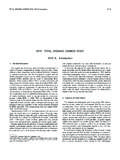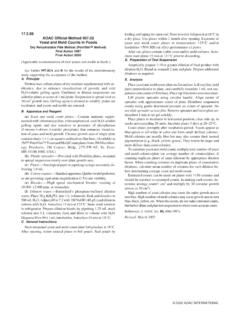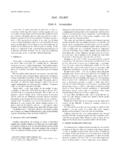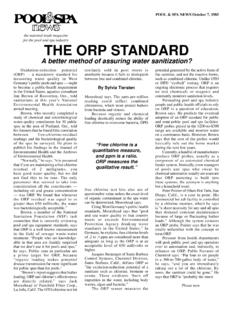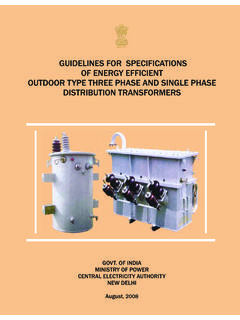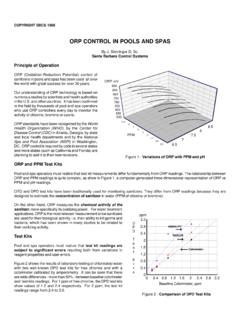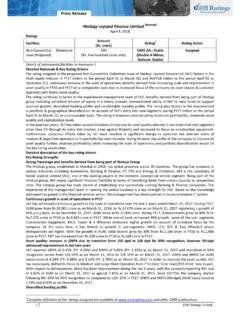Transcription of 4500-Cl CHLORINE (RESIDUAL)* 4500-Cl A. …
1 4500 -Cl CHLORINE ( residual )* 4500 -Cl A. of ChlorinationThe chlorination of water supplies and polluted waters servesprimarily to destroy or deactivate disease-producing microorgan-isms. A secondary benefit, particularly in treating drinking water,is the overall improvement in water quality resulting from thereaction of CHLORINE with ammonia, iron, manganese, sulfide, andsome organic may produce adverse effects. Taste and odor char-acteristics of phenols and other organic compounds present in awater supply may be intensified. Potentially carcinogenic chloroor-ganic compounds such as chloroform may be formed. Combinedchlorine formed on chlorination of ammonia- or amine-bearingwaters adversely affects some aquatic life.
2 To fulfill the primarypurpose of chlorination and to minimize any adverse effects, it isessential that proper testing procedures be used with a foreknowl-edge of the limitations of the analytical Forms and ReactionsChlorine applied to water in its molecular or hypochloriteform initially undergoes hydrolysis to form free CHLORINE con-sisting of aqueous molecular CHLORINE , hypochlorous acid, andhypochlorite ion. The relative proportion of these free chlorineforms is pH- and temperature-dependent. At the pH of mostwaters, hypochlorous acid and hypochlorite ion will CHLORINE reacts readily with ammonia and certain nitrog-enous compounds to form combined CHLORINE . With ammonia, CHLORINE reacts to form the chloramines: monochloramine, di-chloramine, and nitrogen trichloride.
3 The presence and concen-trations of these combined forms depend chiefly on pH, temper-ature, initial CHLORINE -to-nitrogen ratio, absolute CHLORINE de-* Approved by Standard Methods Committee, NONMETALS (4000)mand, and reaction time. Both free and combined CHLORINE maybe present simultaneously. Combined CHLORINE in water suppliesmay be formed in the treatment of raw waters containing am-monia or by the addition of ammonia or ammonium salts. Chlo-rinated wastewater effluents, as well as certain chlorinated in-dustrial effluents, normally contain only combined CHLORINE . His-torically, the principal analytical problem has been to distinguishbetween free and combined forms of of MethodIn two separate but related studies, samples were prepared anddistributed to participating laboratories to evaluate chlorinemethods.
4 Because of poor accuracy and precision and a highoverall (average) total error in these studies, all orthotolidineprocedures except one were dropped in the 14th edition of thiswork. The useful stabilized neutral orthotolidine method wasdeleted from the 15th edition because of the toxic nature oforthotolidine. The leuco crystal violet (LCV) procedure wasdropped from the 17th edition because of its relative difficultyand the lack of comparative Natural and treated waters:The iodometric methods (B andC) are suitable for measuring total CHLORINE concentrationsgreater than 1 mg/L, but the amperometric end point of MethodsC and D gives greater sensitivity. All acidic iodometric methodssuffer from interferences, generally in proportion to the quantityof potassium iodide (KI) and H amperometric titration method (D) is a standard of com-parison for the determination of free or combined CHLORINE .
5 It isaffected little by common oxidizing agents, temperature varia-tions, turbidity, and color. The method is not as simple as thecolorimetric methods and requires greater operator skill to obtainthe best reliability. Loss of CHLORINE can occur because of rapidstirring in some commercial equipment. Clean and conditionedelectrodes are necessary for sharp end low-level amperometric titration procedure (E) has beenadded to determine total CHLORINE at levels below mg/L. Thismethod is recommended only when quantification of such lowresiduals is necessary. The interferences are similar to thosefound with the standard amperometric procedure (D). The DPDmethods (Methods F and G) are operationally simpler for deter-mining free CHLORINE than the amperometric titration.
6 Proceduresare given for estimating the separate mono- and dichloramineand combined fractions. High concentrations of monochloramineinterfere with the free CHLORINE determination unless the reactionis stopped with arsenite or thioacetamide. In addition, the DPDmethods are subject to interference by oxidized forms of man-ganese unless compensated for by a amperometric and DPD methods are unaffected by di-chloramine concentrations in the range of 0 to 9 mg Cl as Cl2/Lin the determination of free CHLORINE . Nitrogen trichloride, ifpresent, may react partially as free CHLORINE in the amperometric,DPD, and FACTS methods. The extent of this interference in theDPD methods does not appear to be free CHLORINE test, syringaldazine (FACTS, Method H)was developed specifically for free CHLORINE .
7 It is unaffected bysignificant concentrations of monochloramine, dichloramine, ni-trate, nitrite, and oxidized forms of color and turbidity may interfere in all contaminants may produce a false free CHLORINE read-ing in most colorimetric methods (see 3bbelow). Many strongoxidizing agents interfere in the measurement of free CHLORINE inall methods. Such interferences include bromine, CHLORINE diox-ide, iodine, permanganate, hydrogen peroxide, and ozone. How-ever, the reduced forms of these compounds bromide, chlo-ride, iodide, manganous ion, and oxygen, in the absence of otheroxidants, do not interfere. Reducing agents such as ferrouscompounds, hydrogen sulfide, and oxidizable organic mattergenerally do not Wastewaters:The determination of total CHLORINE in samplescontaining organic matter presents special problems.
8 Because of thepresence of ammonia, amines, and organic compounds, particularlyorganic nitrogen, residual CHLORINE exists in a combined state. Aconsiderable residual may exist in this form, but at the same timethere may be appreciable unsatisfied CHLORINE demand. Addition ofreagents in the determination may change these relationships so thatresidual CHLORINE is lost during the analysis. Only the DPD methodfor total CHLORINE is performed under neutral pH conditions. Inwastewater, the differentiation between free CHLORINE and combinedchlorine ordinarily is not made because wastewater chlorinationseldom is carried far enough to produce free determination of residual CHLORINE in industrial wastes issimilar to that in domestic wastewater when the waste containsorganic matter, but may be similar to the determination in waterwhen the waste is low in organic of these methods is applicable to estuarine or marinewaters because the bromide is converted to bromine and brom-amines, which are detected as free or total CHLORINE .
9 A procedurefor estimating this interference is available for the DPD the methods given below are useful for the determina-tion of residual CHLORINE in wastewaters and treated effluents, selectthe method in accordance with sample composition. Some indus-trial wastes, or mixtures of wastes with domestic wastewater, mayrequire special precautions and modifications to obtain free CHLORINE in wastewater by any of the methodsprovided that known interfering substances are absent or appro-priate correction techniques are used. The amperometric methodis the method of choice because it is not subject to interferencefrom color, turbidity, iron, manganese, or nitrite nitrogen. TheDPD method is subject to interference from high concentrationsof monochloramine, which is avoided by adding thioacetamideimmediately after reagent addition.
10 Oxidized forms of manga-nese at all levels encountered in water will interfere in allmethods except in the free CHLORINE measurement of amperomet-ric titrations and FACTS, but a blank correction for manganesecan be made in Methods F and FACTS method is unaffected by concentrations of mono-chloramine, dichloramine, nitrite, iron, manganese, and otherinterfering compounds normally found in domestic total CHLORINE in samples containing significant amounts oforganic matter, use either the DPD methods (F and G), ampero-metric, or iodometric back titration method (C) to prevent con-tact between the full concentration of liberated iodine and thesample. With Method C, do not use the starch-iodide end pointif the concentration is less than 1 mg/L.

